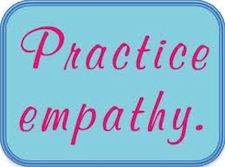
A student recently asked me: What is the opposite of bullying? I answered: empathy. The strength of empathy and the weakness of bullying are mutually exclusive actions. There is neuroscience truth to the adage “walk a mile in my shoes”.
Bullying and empathy are brain-based behaviors found on opposite ends of the emotional continuum. Empathy is a neural function dependent on the mirror neurons. Students say, “Let me try what I see. Let me act on what I feel.”
Mirror neurons look like ordinary motor neurons but have an extraordinary function. These smart highly specialized neurons are not motor neurons - they are designed for communication only. They communicate, or transfer, observational learning to the rest of the brain and then direct the whole brain to take some cognitive, emotional, and/or motor action in response.
The cortical mirror neuron system is the reason that students can reproduce actions after observation only. The mirror neurons cognitively map the action so learners can mimic it. Students learn best not simply by “doing”. They learn best by observation, demonstration, and then duplication. With the help of the mirror neurons, students learn by discernment making a detailed mental note to use as the basis for replication later. The same neurons fire whether children are doing – or only watching - an event because children and adolescents are vicarious learners. They can imagine, intend, anticipate, and emotionally reconstruct what they observe without taking any overt action or actually having the experience themselves. Brains are natural simulators.
What is most amazing is that the mirror neurons do not only simulate and reproduce motor action – they also replicate emotional responses. The mirror neurons can clone other’s feelings, and so, are intensely embroiled in emotional learning. Students do not only duplicate other’s actions, they can also mimic other’s feelings. Mirror neuron fires exactly the same way whether they cry or see another person cry. This phenomenon explains what teachers already know: emotion is neurologically contagious. Mirror neurons enable children to recognize and reproduce emotions by observation. They are able to neurologically recreate the experience and feel another’s emotion, Students do not only see -- they feel -- another’s emotions.
Thus, children marshal empathy using emotional acumen and not reasoning ability. Mirror neurons communicate the intentions and emotions of others to children and they can be encouraged to respond in kind. The emotional strengths of kindness, generosity, forgiveness, and compassion are learned by feeling them -- and not simply by thinking about them. Empathy is compassionate caring that can be nurtured. Teach affection to activate cognition.
So how do children and adolescents learn the feeling of caring so as to demonstrate the strength of empathy? Teach it as a subject – teach it by engendering feelings. Teach the story of young Chief Joseph of the Nez Perces, and his tragic journey on the Lo Lo Trail. Feel the feelings behind his brave words, “I will fight no more forever”.
Teach students to walk the trail with him and feel the blisters on his heart.
--------------------
How do you define bullying? Do you define it as emotional or physical abuse? Hostile actions to intimidate, embarrass, hurt, or punish another with less power or status? What role can empathy play in reducing hostile actions to those who are vulnerable? How are empathy and tolerance related? Do you teach empathy in any systematic way? Do you teach it using specific methods or materials: fiction, non-fiction, film, journaling, storytelling, art, music, dance, drama, or other medium? Do you direct students to acknowledge, recognize, and respond to other’s emotions both positive and negative? How do you do it? Does it change the classroom or school culture or climate? Do you have time and support to connect feelings – especially empathy – to actions as a ‘teachable’ moments while teaching academic subjects? Can you design empathetically focused lessons in a given discipline?
Notes
Articles
Blakeslee, Sandra. (January 10, 2006). Cells that read minds. New York: New York Times.
Thomas, Ben (November 6, 2012). What’s so special about mirror neurons? New York: Scientific American.
March, J. (March 29, 2012). Do mirror neurons give us empathy? Berkeley: Greater Good Science Center.
Winerman, L. (October, 2005). Mind’s mirror. Washington: APA Monitor, (36) 9, p. 48.
Klass, P. (December 10, 2012). Understanding how children develop empathy. New York: New York Times.
Books
Bandura, A (1976). Social learning theory. New York: Pearson.
Decety, J. & Ickes, W. (2011). The social neuroscience of empathy. Boston: MIT Press.
Videos
PBS Mirror Neuron
Ted Talk (November, 2009). VS Ramachandran: The neurons that shaped civilization.
Web Resources
Laboratory for Affective Neuroscience
Richard Davidson (My Favorite Neuroscientist!)
UC Berkeley Greater Good Science Center Empathy
AVAILABLE NOW:
Positive Psychology in the Elementary School Classroom and is the first in a series intended to help teachers build positive psychology classrooms. http://books.wwnorton.com/books/Author.aspx?id=23961
Author Page: www.pattyogrady.com




